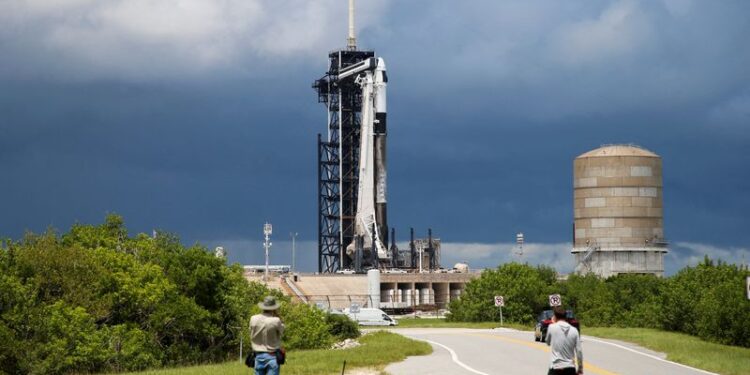By Joey Roulette
WASHINGTON (Reuters) -The U.S. Federal Aviation Administration on Wednesday said SpaceX’s workhorse Falcon 9 rocket has been grounded after failing an attempt to land back on Earth during a routine Starlink mission, forcing the company’s second grounding this year.
SpaceX’s Falcon 9 successfully launched a batch of Starlink internet satellites into orbit early on Wednesday morning from Florida. The rocket’s reusable first stage booster returned to Earth and attempted to land on a sea-faring barge as usual, but toppled into the ocean after a fiery touchdown, a SpaceX live stream showed.
“The incident involved the failure of the Falcon 9 booster rocket while landing on a droneship at sea. No public injuries or public property damage have been reported. The FAA is requiring an investigation,” an FAA spokesperson said.
Groundings of Falcon 9, a rocket that much of the Western world relies on to put satellites and humans in space, are rare. The rocket was last grounded in July for the first time since 2016, following a second-stage failure in space that doomed a batch of Starlink satellites.
Though no satellites or people were endangered during Wednesday’s flight, the landing failure indicated something in the rocket went wrong that the FAA tends to believe could pose a greater risk in future missions if not thoroughly investigated.
The rocket’s grounding could delay the launch of SpaceX’s high-profile Polaris (NYSE:) Dawn mission with four private astronauts who are poised to attempt the first private spacewalk. The Polaris mission had been expected to launch this week but was delayed by a launchpad hitch, and then again over bad weather.
After the July grounding, SpaceX returned Falcon 9 to flight 15 days later, after the FAA granted the company’s request for an expedited return to flight.
Falcon 9 is also due to launch two NASA astronauts in late September on a Crew Dragon spacecraft that will bring home next year the two astronauts who have been stuck on the International Space Station after riding Boeing (NYSE:)’s troubled Starliner spacecraft.
NASA regulates Falcon 9 for its own missions. It was not immediately clear how the rocket’s latest grounding will affect that NASA mission. The U.S. space agency did not immediately respond to a request for comment.
SpaceX has built a sizable fleet of reusable Falcon boosters since the rocket’s first launch in 2010 that has allowed the company to vastly outpace its rivals in launch frequency. The individual booster that failed on Wednesday was on its 23rd flight, SpaceX wrote on X.
“After a successful ascent, Falcon 9’s first stage booster tipped over following touchdown on the A Shortfall of Gravitas droneship,” SpaceX said, referring to the large ship the booster was supposed to land on.
Another Starlink mission was poised for launch shortly after Wednesday’s flight, from SpaceX’s other launch site in southern California, but the company called that mission off after the landing failure.

The FAA regulates private rockets and launch site safety to the extent they impact the safety of the uninvolved public. The agency on Wednesday required SpaceX to open an investigation that the FAA will oversee.
“A return to flight of the Falcon 9 booster rocket is based on the FAA determining that any system, process, or procedure related to the anomaly does not affect public safety,” the FAA said.







